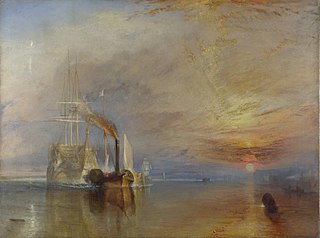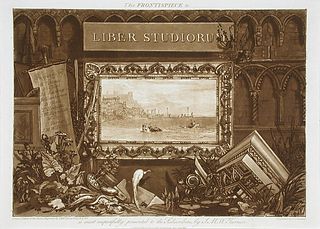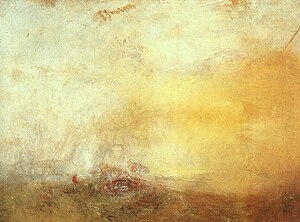
Joseph Mallord William Turner, known in his time as William Turner, was an English Romantic painter, printmaker and watercolourist. He is known for his expressive colouring, imaginative landscapes and turbulent, often violent marine paintings. He left behind more than 550 oil paintings, 2,000 watercolours, and 30,000 works on paper. He was championed by the leading English art critic John Ruskin from 1840, and is today regarded as having elevated landscape painting to an eminence rivalling history painting.
In mathematics, monstrous moonshine, or moonshine theory, is the unexpected connection between the monster group M and modular functions, in particular, the j function. The term was coined by John Conway and Simon P. Norton in 1979.

The Fighting Temeraire, tugged to her last berth to be broken up, 1838 is an oil-on-canvas painting by the English artist Joseph Mallord William Turner, painted in 1838 and exhibited at the Royal Academy in 1839.
Events from the year 1845 in art.

Edwin John Victor Pasmore, CH, CBE was a British artist. He pioneered the development of abstract art in Britain in the 1940s and 1950s.

The Dunedin Public Art Gallery holds the main public art collection of the city of Dunedin, New Zealand. Located in The Octagon in the heart of the city, it is close to the city's public library, Dunedin Town Hall, and other facilities such as the Regent Theatre.

Tate Britain, known from 1897 to 1932 as the National Gallery of British Art and from 1932 to 2000 as the Tate Gallery, is an art museum on Millbank in the City of Westminster in London, England. It is part of the Tate network of galleries in England, with Tate Modern, Tate Liverpool and Tate St Ives. It is the oldest gallery in the network, having opened in 1897. It houses a substantial collection of the art of the United Kingdom since Tudor times, and in particular has large holdings of the works of J. M. W. Turner, who bequeathed all his own collection to the nation. It is one of the largest museums in the country. The museum had 525,144 visitors in 2021, an increase of 34 percent from 2020 but still well below pre- COVID-19 pandemic levels. In 2021 it ranked 50th on the list of most-visited art museums in the world.

Chichester Canal is a painting by the English Romantic landscape painter, watercolourist and printmaker J. M. W. Turner. It was painted in 1828 and was commissioned by George Wyndham, 3rd Earl of Egremont. It is now in the Tate Collection.

The Burning of the Houses of Lords and Commons, 16th October, 1834 is the title of two oil on canvas paintings by J. M. W. Turner, depicting different views of the fire that broke out at the Houses of Parliament on the evening of 16 October 1834. They are now in the Philadelphia Museum of Art and Cleveland Museum of Art.

Snow Storm: Hannibal and his Army Crossing the Alps is an oil on canvas painting by J. M. W. Turner, first exhibited in 1812. Left to the nation in the Turner Bequest, it was acquired by the National Gallery in London in 1856, and is now held by the Tate Gallery.

Dido building Carthage, or The Rise of the Carthaginian Empire is an oil on canvas painting by J. M. W. Turner. The painting is one of Turner's most important works, greatly influenced by the luminous classical landscapes of Claude Lorrain. Turner described it as his chef d'oeuvre. First exhibited at the Royal Academy summer exhibition in 1815, Turner kept the painting until he left it to the nation in the Turner Bequest. It has been held by the National Gallery in London since 1856.

Circe Invidiosa is a painting by John William Waterhouse completed in 1892. It is his second depiction, after Circe Offering the Cup to Ulysses (1891), of the classical mythological character Circe. This particular mythological portrayal is based on Ovid's tale in Metamorphoses, wherein Circe turns Scylla into a sea monster, solely because Glaucus scorned the enchantress' romantic advances in hopes of attaining Scylla's love instead. Waterhouse later returned to the subject of Circe a third time with The Sorceress (1911). Circe Invidiosa is part of the collection of the Art Gallery of South Australia, which also owns Waterhouse's 1883 The Favourites of the Emperor Honorius.

Snow Storm, or Snow Storm: Steam-Boat off a Harbour's Mouth, is a painting by English artist Joseph Mallord William Turner (1775–1851) from 1842.

Liber Studiorum is a collection of prints by J. M. W. Turner. The collected works included seventy-one prints that he worked on and printed from 1807 to 1819. For the production of the prints, Turner created the etchings for the prints, which were worked in mezzotint by his collaborating engravers.

In 1842, British artist J. M. W. Turner painted three watercolours of the Rigi, a mountain in the Alps in Central Switzerland, which he had visited the previous summer. Widely regarded as some of his finest works, the watercolours capture the transitory effects of light and atmospheric conditions at the Rigi. According to John Ruskin, "Turner had never made any drawings [watercolours] like these before, and never made any like them again ... He is not showing his hand in these, but his heart."

Fishermen at Sea, sometimes known as the Cholmeley Sea Piece, is an early oil painting by English artist J. M. W. Turner. It was exhibited at the Royal Academy in 1796 and has been owned by the Tate Gallery since 1972. It was the first oil painting by Turner to be exhibited at the Royal Academy. It was praised by contemporary critics and burnished Turner's reputation, both as an oil painter and as a painter of maritime scenes.

Norham Castle, Sunrise is an oil-on-canvas painting by English painter J. M. W. Turner, created around 1845. The painting depicts Norham Castle, overlooking the River Tweed, the border between England and Scotland. The painting was bequeathed to the National Gallery of British Art as part of the Turner Bequest in 1856. It remains in the collection to this day. It was one of the artist's last paintings, and falls within his "Modernist" period. This piece is well known for Turner's attentiveness to dawn light, and the softened silhouette it brings.

The Golden Bough is a painting from 1834 by the English painter J. M. W. Turner. It depicts the episode of the golden bough from the Aeneid by Virgil. It is in the collection of the Tate galleries.

Peace – Burial at Sea is a painting in oils on canvas by the English Romantic artist J. M. W. Turner (1775–1851), first exhibited in 1842. The work is a memorial tribute to Turner's contemporary the Scottish painter Sir David Wilkie (1786–1841). The canvas depicts Wilkie's burial at sea. This work was intended as a companion piece to War. The Exile and the Rock Limpet which alludes to the sordid demise of the former Emperor of France Napoleon Bonaparte. The two works are characterized by sharply contrasting colors and tones: War utilizes a strident yellow and red while Peace is painted a cool blend of white, blue and black.


















